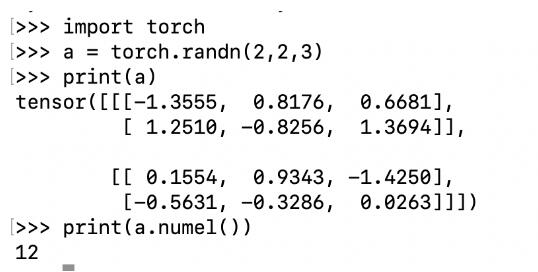import torch
# 引入torch.nn并指定别名
import torch.nn as nn
import torch.nn.functional as F
class Net(nn.Module):
def __init__(self):
# nn.Module子类的函数必须在构造函数中执行父类的构造函数
super(Net, self).__init__()
# 卷积层 '1'表示输入图片为单通道, '6'表示输出通道数,'3'表示卷积核为3*3
self.conv1 = nn.Conv2d(1, 6, 3)
#线性层,输入1350个特征,输出10个特征
self.fc1 = nn.Linear(1350, 10) #这里的1350是如何计算的呢?这就要看后面的forward函数
#正向传播
def forward(self, x):
print(x.size()) # 结果:[1, 1, 32, 32]
# 卷积 -> 激活 -> 池化
x = self.conv1(x) #根据卷积的尺寸计算公式,计算结果是30,具体计算公式后面第二张第四节 卷积神经网络 有详细介绍。
x = F.relu(x)
print(x.size()) # 结果:[1, 6, 30, 30]
x = F.max_pool2d(x, (2, 2)) #我们使用池化层,计算结果是15
x = F.relu(x)
print(x.size()) # 结果:[1, 6, 15, 15]
# reshape,‘-1'表示自适应
#这里做的就是压扁的操作 就是把后面的[1, 6, 15, 15]压扁,变为 [1, 1350]
x = x.view(x.size()[0], -1)
print(x.size()) # 这里就是fc1层的的输入1350
x = self.fc1(x)
return x
net = Net()
Parameter containing:
tensor([[[[-0.0104, -0.0555, 0.1417],
[-0.3281, -0.0367, 0.0208],
[-0.0894, -0.0511, -0.1253]]],
[[[-0.1724, 0.2141, -0.0895],
[ 0.0116, 0.1661, -0.1853],
[-0.1190, 0.1292, -0.2451]]],
[[[ 0.1827, 0.0117, 0.2880],
[ 0.2412, -0.1699, 0.0620],
[ 0.2853, -0.2794, -0.3050]]],
[[[ 0.1930, 0.2687, -0.0728],
[-0.2812, 0.0301, -0.1130],
[-0.2251, -0.3170, 0.0148]]],
[[[-0.2770, 0.2928, -0.0875],
[ 0.0489, -0.2463, -0.1605],
[ 0.1659, -0.1523, 0.1819]]],
[[[ 0.1068, 0.2441, 0.3160],
[ 0.2945, 0.0897, 0.2978],
[ 0.0419, -0.0739, -0.2609]]]])
Parameter containing:
tensor([ 0.0782, 0.2679, -0.2516, -0.2716, -0.0084, 0.1401])
Parameter containing:
tensor([[ 1.8612e-02, 6.5482e-03, 1.6488e-02, ..., -1.3283e-02,
1.8715e-02, 5.4037e-03],
[ 1.8569e-03, 1.8022e-02, -2.3465e-02, ..., 1.6527e-03,
2.0443e-02, -2.2009e-02],
[ 9.9104e-03, 6.6134e-03, -2.7171e-02, ..., -5.7119e-03,
2.4532e-02, 2.2284e-02],
...,
[ 6.9182e-03, 1.7279e-02, -1.7783e-03, ..., 1.9354e-02,
2.1105e-03, 8.6245e-03],
[ 1.6877e-02, -1.2414e-02, 2.2409e-02, ..., -2.0604e-02,
1.3253e-02, -3.6008e-03],
[-2.1598e-02, 2.5892e-02, 1.9372e-02, ..., 1.4159e-02,
7.0983e-03, -2.3713e-02]])
Parameter containing:
tensor(1.00000e-02 *
[ 1.4703, 1.0289, 2.5069, -2.2603, -1.5218, -1.7019, 1.2569,
0.4617, -2.3082, -0.6282])


